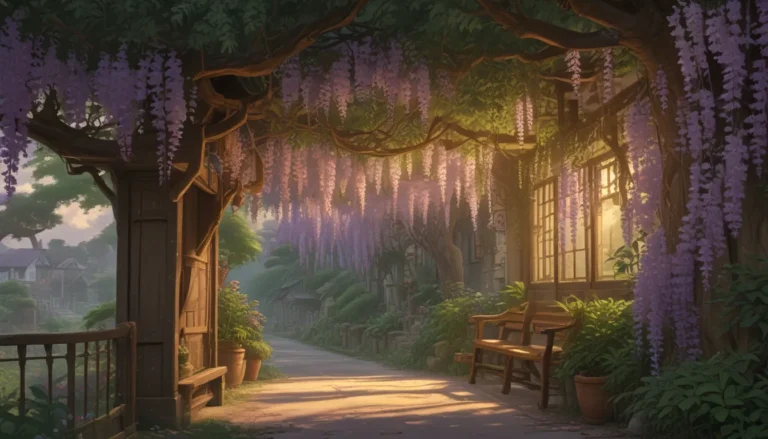Ultimate Guide to Growing ‘Crimson Queen’ Japanese Maple Trees

Everything You Need to Know About Acer palmatum var. dissectum ‘Crimson Queen’
If you’re a gardener who appreciates the beauty of Japanese Maples, ‘Crimson Queen’ is a variety that will surely captivate you. This dwarf tree boasts shockingly bright red fall foliage, delicate lace-like serrated leaves, and a cascading growth habit that can serve as a stunning focal point in your garden.
‘Crimson Queen’ is the epitome of a cascading red Japanese maple with its elegant lacy leaves, making it a top choice among Japanese maple cultivars.
While this tree is indeed a garden favorite, it does come with specific requirements to ensure it thrives. In this comprehensive guide, we will delve into all the essential aspects of growing and caring for ‘Crimson Queen’ so you can enjoy the beauty of this unique variety in your landscape.
As an Amazon Associate, we link to vendors to help you find relevant products. If you make a purchase through one of our links, we may earn a commission.
What You’ll Learn
- Cultivation and History
- Propagation
- How to Grow
- Growing Tips
- Pruning and Maintenance
- Where to Buy
- Managing Pests and Disease
- Best Uses
- Quick Reference Growing Guide
If you’re eager to start your journey of growing ‘Crimson Queen’ Japanese Maple trees, let’s dive right in!
Cultivation and History of ‘Crimson Queen’
‘Crimson Queen’ is a weeping Japanese maple cultivar that falls under the dissectum category. These trees are known for their smaller size compared to the species and their shrubby shape with a cascading habit.
Originating in the United States in 1965, ‘Crimson Queen’ quickly gained commercial success and even won the RHS Award of Garden Merit in 1993. It takes approximately 15 years for this dwarf cultivar to reach its mature size, growing to about five feet tall and seven feet wide.
While ‘Crimson Queen’ may grow slightly taller in ideal conditions with ample sunlight and moisture, it typically stays around five feet in height. Planting this tree in a shady spot can keep it much smaller in size. With some pruning, you can train the tree to the desired height and shape, making it a versatile addition to any garden.
Propagation and Growing ‘Crimson Queen’
Propagation of ‘Crimson Queen’ Japanese Maple trees usually involves grafting rather than growing from seed. If you choose to propagate from seed, keep in mind that the results may not be consistent. It’s recommended to stick to planting purchased plants or taking cuttings to ensure successful propagation.
Whether you start with a purchased plant or cuttings, spring or fall is the best time of year for propagation. When planting a new tree, ensure the soil remains consistently moist for the first year, resembling the texture of a well-wrung kitchen sponge.
Space the trees about four feet away from buildings, other plants, or fences to allow ample room for growth and development.
How to Grow ‘Crimson Queen’ Japanese Maple
Like most Japanese maples, ‘Crimson Queen’ thrives in loamy, rich, and moist soil. It can also tolerate sandy loam as long as the soil remains slightly acidic with a pH between 5.5 to 6.5.
After the initial year of planting, allow the top few inches of soil to dry out between waterings. Applying an inch or two of organic mulch around the tree can help retain moisture and suppress weeds, but avoid piling the mulch against the trunk.
To prevent leaf scorch, ensure regular watering and provide afternoon shade to protect the tree from excessive sun exposure. ‘Crimson Queen’ performs best in locations with temperate summers, but with proper care, it can thrive in warmer regions as well.
In regions with cooler summers such as the Pacific Northwest or northern Atlantic coast, ‘Crimson Queen’ can be grown in full sun. For warmer climates in the West or Midwest, consider providing afternoon shade to prevent leaf scorch.
Maintain a consistent irrigation routine, especially during warm weather, to keep your ‘Crimson Queen’ healthy and thriving. Planting in Zone 4 is possible with careful site selection, such as placing the tree near a south-facing wall for added warmth and protection.
Growing Tips for ‘Crimson Queen’
When cultivating ‘Crimson Queen’ Japanese Maple trees, keep the following tips in mind:
- Choose a location with full sun in cooler climates or afternoon shade in warmer regions.
- Water the tree when the top two or three inches of soil dry out to prevent leaf scorch.
- Maintain sufficient hydration, especially during high heat periods.
Pruning and Maintenance of ‘Crimson Queen’
To maintain the stunning appearance of your ‘Crimson Queen’ Japanese Maple, regular pruning is essential. Weeping varieties like ‘Crimson Queen’ require extra attention to highlight their unique shape.
Cultivate the tree by pruning the center to keep three to five main branches for an aesthetically pleasing appearance. Carefully curate the branches to create a dramatic crown shape that accentuates the beauty of the tree.
Pruning can be done throughout the year for diseased, dead, or damaged branches, while shaping should be performed in winter when the temperature is above freezing. For a comprehensive guide on pruning Japanese maples, refer to our detailed resource.
Where to Buy ‘Crimson Queen’ Japanese Maple
‘Crimson Queen’ Japanese Maple trees are widely available at garden centers and plant nurseries. Popular online retailers like Nature Hills Nursery and Fast Growing Trees offer live plants of various sizes to suit your preferences.
Nature Hills Nursery carries ‘Crimson Queen’ in sprinter pots, while Fast Growing Trees provides one to two-foot or two to three-foot trees for your convenience.
Managing Pests and Disease for ‘Crimson Queen’
As with other Japanese Maples, ‘Crimson Queen’ is susceptible to common pests and diseases that affect this plant family. Look out for aphids, borers, scale, anthracnose, powdery mildew, Pseudomonas, root rot, and verticillium wilt as potential issues.
Regular monitoring of the tree for symptoms like yellowing or browning leaves, wilting, stunted growth, or leaf drop can help identify problems early. For a comprehensive guide on managing pests and diseases in Japanese maples, refer to our detailed resource.
Best Uses for ‘Crimson Queen’ Japanese Maple
‘Crimson Queen’ Japanese Maple trees are ideal for specimen plantings, creating a captivating focal point in the garden with their vibrant red foliage. They also thrive in containers, making them suitable for large planters or bonsai pots.
The unique shape and color of ‘Crimson Queen’ add visual interest to the landscape throughout the seasons, making it a versatile ornamental tree for various garden settings.
Quick Reference Growing Guide for ‘Crimson Queen’
Plant Type: Deciduous tree
Foliage Color: Red, bronze, green
Native to: China, Japan, Korea
Tolerance: Some shade
Hardiness (USDA Zone): 4b-9b
Soil Type: Sandy, loamy, silty, loamy clay
Season: Spring
Soil pH: 5.5-6.5
Exposure: Full sun to partial shade
Soil Drainage: Well-draining
Time to Maturity: 15 years
Attracts: Birds
Planting Depth: Same depth as container (graft exposed)
Companion Planting: Black walnut, camellia, crocus, dwarf conifer, ginkgo, iris, hellebores, hosta, rhododendron
Spacing: 4 feet
Avoid Planting With: Barberry, cacti, crocus, forsythia
Height: Up to 8 feet
Uses: Bonsai, container planting, specimen
Spread: Up to 10 feet
Family: Sapindaceae
Growth Rate: Slow
Genus: Acer
Water Needs: Moderate-high
Maintenance: Moderate
Common Pests and Disease: Aphids, borers, maple scale; Anthracnose, powdery mildew, pseudomonas, root rot, verticillium wilt
Cultivar: Crimson Queen
All Hail the Queen of Japanese Maples
‘Crimson Queen’ Japanese Maple trees are an undeniable beauty in any garden, offering striking visual appeal and vibrant color throughout the seasons. Their cascading growth habit and lacy leaves make them a top choice for gardeners seeking a captivating ornamental tree.
How will you showcase the beauty of ‘Crimson Queen’ in your garden? Whether in a container, as a specimen planting, or part of a Japanese-themed landscape, this regal tree is sure to command attention and admiration.
Share your plans for growing ‘Crimson Queen’ in the comments below and continue your Japanese maple journey with our recommended guides:
- Japanese Maple Lifespan: How Long Can These Trees Live?
- How to Deal with Japanese Maple Winter Dieback
- How to Grow and Care for Coral Bark Japanese Maple Trees
Explore the world of Japanese maples further and unlock the full potential of these exquisite trees in your garden!
Cover Image: Alamy
By restructuring the information from the original article into a more detailed and educational format, this rewritten guide enhances the reader’s understanding of growing ‘Crimson Queen’ Japanese Maple trees. With practical tips, in-depth advice, and additional sections, this comprehensive article aims to provide valuable insights for both novice and experienced gardeners.





